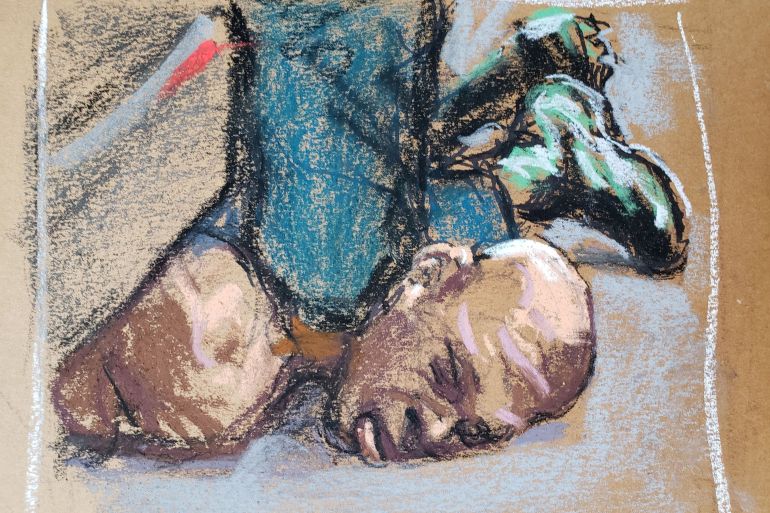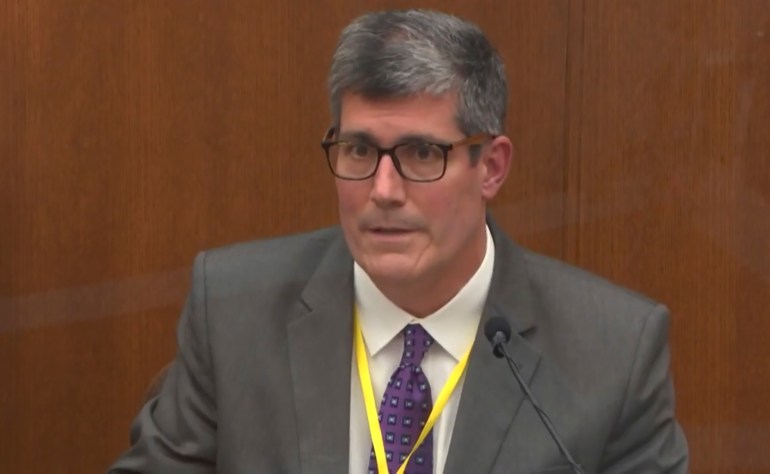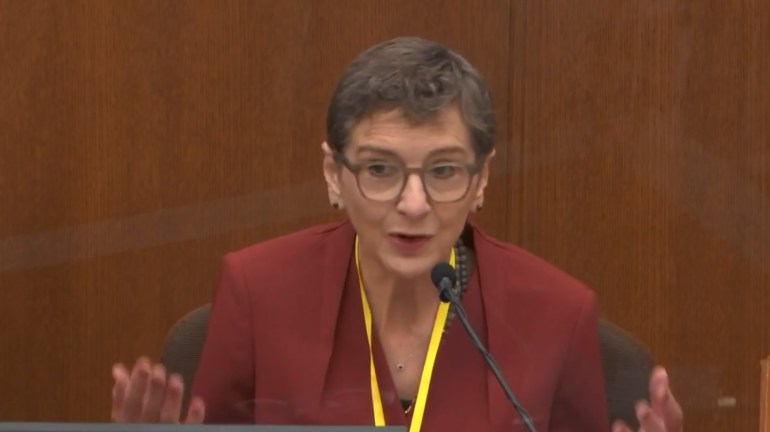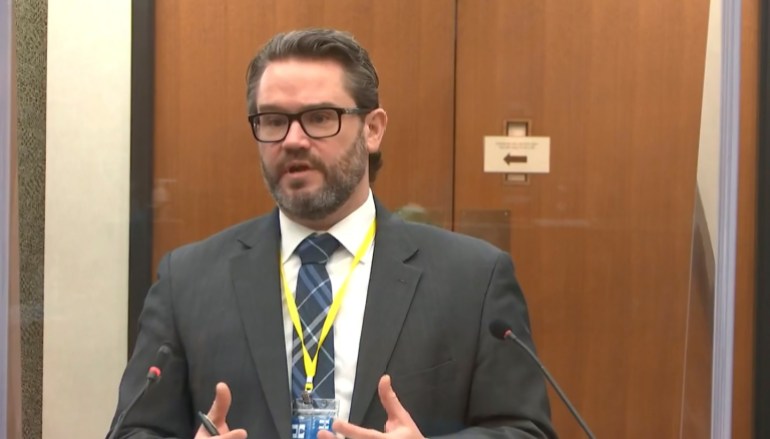George Floyd autopsy doctor stands by homicide ruling
The medical examiner who performed the autopsy testified in the trial of former Minneapolis police officer Derek Chauvin.

The chief medical examiner who ruled George Floyd’s death a homicide testified Friday that the way police held him down and compressed his neck “was just more than Mr Floyd could take”, given the condition of his heart.
Dr Andrew Baker, the Hennepin County medical examiner, took the stand at the murder trial of former officer Derek Chauvin for pressing his knee on or close to Floyd’s neck for what prosecutors said was as much as nine and a half minutes as the 46-year-old Black man lay pinned to the pavement last year.
Keep reading
list of 3 items‘A bad dream’: Derek Chauvin trial revives painful memories
What to expect in week two of the Derek Chauvin trial
Asked about his finding that police “subdual, restraint and neck compression” led to Floyd’s death, Baker said that Floyd had severe underlying heart disease and an enlarged heart that needed more oxygen than normal to function, as well as narrowing of two heart arteries.

Baker said being involved in a scuffle raises adrenaline, which asks the heart to beat even faster and supply more oxygen.
“And in my opinion, the law enforcement subdual, restraint and the neck compression was just more than Mr Floyd could take by virtue of that, those heart conditions,” the medical examiner said.
Chauvin, 45, is charged with murder and manslaughter in Floyd’s death on May 25. Floyd was arrested outside a neighbourhood market after being accused of trying to pass a counterfeit $20 bill.
Bystander video of Floyd crying that he could not breathe as onlookers yelled at the white officer to get off him sparked protests and scattered violence around the US.
Chauvin lawyer Eric Nelson has argued that the now-fired white officer did what he was trained to do and that Floyd’s illegal drug use and underlying health conditions, not Chauvin’s knee, killed him. An autopsy found fentanyl and methamphetamine in Floyd’s system.
“Mr Floyd’s use of fentanyl did not cause the subdual or the neck restraint, his heart disease did not cause the subdual or the neck restraint,” Baker told the jury, referring to the way police pressed Floyd facedown against the street.

Dr Lindsey Thomas, an assistant medical examiner in the Hennepin County medical examiner’s office until she went into “semi-retirement” in 2017, said the sheer volume of videos of Floyd’s arrest helped support Baker’s findings.
“There’s never been a case I was involved in that had videos over such a long time frame and from so many different perspectives,” Thomas testified, saying the videos made it clear physical signs associated with opioid overdose were not present in Floyd’s death.
Thomas said the videos made clear this was not a sudden death from a heart attack. She said the videos also did not show signs of a fentanyl overdose “where someone becomes very sleepy and then just sort of gradually, calmly, peacefully stops breathing.”
“What was absolutely unique in this case was the volume of materials I had to review,” Thomas said, referring to videos recorded on bystanders’ mobile phones and police body-worn cameras.
Jurors were also handed envelopes containing photographs of Floyd’s corpse. Thomas drew their attention to abrasions on the left side of Floyd’s face and his shoulder – wounds she called “consistent with what it looks like on the video, that he’s struggling to push himself into a position where he can breathe.”

Eric Nelson, Chauvin’s lead lawyer, got Thomas to agree that being prone was not in itself sufficient to kill someone, noting that massage therapists sometimes have clients lie face down.
“I could be laying by the pool in Florida on my stomach in the prone position – not inherently dangerous?” Nelson asked.
“Right,” Thomas replied.
Nelson asked her about hypothetical scenarios, with Floyd being found dead in different circumstances in which police were not involved.
Prosecutor Jerry Blackwell subsequently asked Thomas, “George Floyd was not laying by the pool on his stomach in Florida, was he?”
Thomas agreed, saying, “There’s no evidence to suggest he would have died that night except for the interactions with law enforcement.”